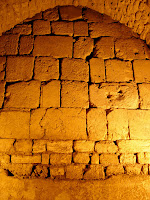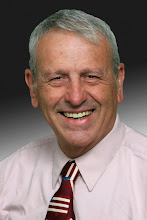JERUSALEM JOURNAL: DAY 7 - SATURDAY, JANUARY 2, 2010
COMMENTARY
Things are a bit better in the Todd department, except for a couple of things that continue to add to my disappointment concerning this person who has such great potential. This morning, he took us to a site that would allow us access to Bethany through the Israeli Wall. Although the crossing was closed, it shows Todd’s interest in trying to teach us and give us a unique experience during our presence in Israel. He also took us to Solomon’s Pools and Herodion, two places that a regular tourist will never see. I will value those experiences.
On the other hand, we also went to Bethlehem, and since it was the Jewish Shabbat, all of the Jewish sites were, of course, closed. We waited in line to visit the place where tradition says Jesus was born for over an hour, when Todd came up and told everybody that, no matter what, we would have to be back at the bus by 1:30 PM. Several students decided to leave so that they could have their lunch and missed seeing the site. Thankfully, the group that I was with made it out by 12:55, and so I was able to buy my Shwarma Loffa (loffa bread rolled around lamb and other condiments). Yet, despite my negative impression of the site because of the crowds and commercialism, I think it is a shame that many of our group missed seeing it; and I think that our instructor could have been a little more sensitive to people and a little less sensitive to time. Other than that, I have had a wonderful day. My back and my knees are still bothering me, but either I am feeling a bit better, or I am bearing up under the discomfort a bit more graciously.
I tripped and pulled my back out early in December, and, although it has healed, there is still a lot of discomfort from climbing and fast walking. As a result, I received my first Paper Plate Award from the other students. These awards are given out to those who either do exemplary or very funny things. My award was The Bionic Man Award, for holding up under the discomfort of my back problems.
MOUNT OF OLIVES :

As I mentioned earlier, we attempted to cross through a check point into Bethany, on the other side of the Arab/Israeli wall. The wall has affected all, especially those Arabs who live in the area. Yet, it has cut down on the suicide bombings. We were going to try to take the road that Jesus took from Bethany to Bethpage, where, on what we call “Palm Sunday” He mounted the donkey and triumphantly rode into Jerusalem. Zechariah prophesied that the King would come on a donkey, and when he did, the crowds shouted, “Hosanna (or Glory) to the son of David, almost the same words that the angels said at his birth, “Glory to God in the highest.” The entry into Jerusalem on a donkey by Jesus is definitely a messianic act. Then, when the Pharisees want Jesus to disperse the crowd, he angers them by suggesting that if the crowd was quiet, even the rocks would cry out. This, of course angered them, and then Jesus next act was to clear the temple of money changers, another act that is clearly messianic in nature. It is clear that Jesus does everything to fulfill scripture, and Todd suggests that the same crowd who lauded Him on Palm Sunday rejected him on Good Friday and that guilt is imputed to us, as well.
We stopped at the Mount of Olives overlook where we had a spectacular view of the old city. We could see the Golden Gate, which is the only Eastern Gate and was sealed by Moslems in 630 AD because some traditions suggest that this is the gate that the Messiah would return through when he came again. Sites that we could pick out included the Dome of the Rock, El Aqsa Mosque, the Church of the Resurrection, the Lutheran Church of the Redeemer. We could also see Nebi Samwil in the distance, the place where we visited yesterday morning and was the alleged tomb of the prophet Samuel. We were told that the Temple was much higher and more spectacular than the Dome of the Rock, that we now see.
We visited the Russian Orthodox Church, Dominus Flevit, which means “The Lord Wept.” There we viewed ossuaries which had been found in the area. During Jesus lifetime, it was the custom for people to have two burials. The first burial involved placing the whole body in the tomb, and the Cenomanian Limestone helped the decomposition process. In about a year, only bones were left and those bones were placed in an ossuary. The size of the ossuary is the length of the human femur by the height and width of the skull. The ossuary of the High Priest Caiaphas has been found along with Simon the Temple Builder and one which Todd thinks is real, James, the son of Joseph, brother of Jesus.
GARDEN OF GETHSEMANE:
Todd thinks that this, or another place in the area is the site of the garden. The word Gethsemane means Oil Press, and on the site there is an olive press located in a cave. The fact that the Byzantines and the Crusaders built churches one, right on top of the other, suggest that this is also the site. The olive trees there, however, are not as old as Jesus, since, as Josephus stated, all the trees were cut down within an 11 mile radius of the city when it was destroyed by the Romans. Todd suggests that the Last Discourse took place either in the upper room or on the way to the garden (Matthew 26).
BETHLEHEM AND THE CHURCH OF THE NATIVITY:

This seems to be the real place of Jesus’ birth, and that birth took place in the caves underneath that church. Todd also brought up the theory that the word “Kataluna”, which was interpreted to mean “Inn” may have actually meant “upper room”. And Mary and Joseph may have been at the house of a relative where the upper room was not available. Mary, being pregnant and single, may have been offered the lowest place to stay because she was considered to have brought shame to her husband’s family. Bethlehem means “House of Bread” and was a tiny village at the time of Christ. It borders the edge of the wilderness and therefore is more ideal for sheep than for agriculture. Hence, the shepherd in the hills at the time of Jesus’ birth. The Church of the Nativity, itself was built by Queen Helena, mother of Constantine, in 330 AD after she was told of the Bethlehem birthplace. The core structure was rebuilt in the time of Justinian in 530 AD. Neither the Persians nor the Crusaders attempted to destroy it.
SOLOMON’S POOLS:
There were three massive reservoirs south of Bethlehem that were built by Herod the Great, who should have been called “Herod the Builder”. The three pools were supplied via aqueducts from springs south of Bethlehem and then distributed water via two aqueducts to Jerusalem and to Herodion, Herod’s fortress and summer palace. The aqueducts, themselves may have been sixty miles in length. Pilate stole money from the treasury for the project. Both Bethlehem and Hebron are at a higher altitude than Jerusalem, and therefore the distribution system was an easy possibility. The ruins of Etam are below where Sampson killed 1,000 Philistines with the jawbone of an ass (Judges, Chapter 15).
HERODION:

This fortress and summer palace of Herod was later occupied by Jews during both Jewish revolts. On the site, there is a theater built by Herod, as well as his tomb. Herod’s body was brought on a golden deer to this location for burial. One can see the catapult balls that the Romans used to attack this fortress during rebel siege. Tunnels were made by the rebels through the cisterns inside the mountain, so that they could sneak out and conduct raids on Roman resources. The courtyard was where we entered from the cistern tunnels. There is also a bathhouse, and during the period between 866-871, the dining room was converted to a synagogue. The reason Herod had great resources for building was because his wife (a Hasmonean) was well to do, and he was also working for the Romans. From the top of the Fort, we were able to see the Dead Sea and the mountains of Jordan, where Amman (remember the Ammonites?) is the capital. We could also see Tekoa, from where the prophet Amos, who prophesied to the Northern Kingdom came. Tekoa’s Arab name is Tequa. Often Biblical sites are identified from their Arab names.
































































